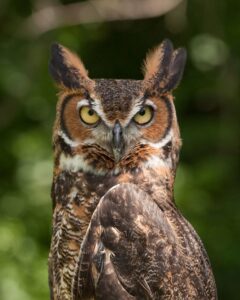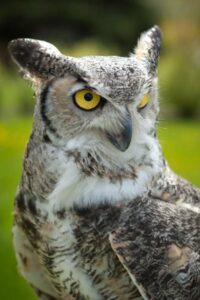Most Alaskans are familiar with the Great Horned Owl (Bubo virginianus) for it is one of our commonest large raptors and has the most widespread range of all North American owls. Many folks south of the Arctic treeline have at sometime either observed this magnificent bird in the woods or listened on a still evening to its legendary hooting — a soft but vibrant whoo-whoo-whoo-whoo- whoo-whoo. The deep resonant hoots are given in various rhythms by different individuals, but usually it is a four to six-noted hoot with the female¹s being softer and higher in pitch. Here in the Interior we can enjoy their deep hoots rolling across the forest throughout the winter nights. The geographic range of the Great Horned Owl encompasses virtually all of the forested and semi- forested regions of North, Central and South America. As long as available prey are in adequate supply, these owls are usually year-round residents and the young normally will not move very far from the area in which they were born. There are, however, mass movements of Great Horned Owls following cyclic declines of snowshoe hare populations in the boreal forest. These emigrations are prompted by widespread scarcity of food in winter.
The most notable physical attributes of the Great Horned Owl are its large size and its large, widely spaced ear tufts or ³horns² which are feathers. Owls, especially those that hunt at night have extremely sensitive hearing and can locate even faint sounds with remarkable accuracy. A number of owl species (at least 8), have asymmetrical openings to their ears, which helps determine the direction and height of a sound. Hearing is enhanced by the facial ruff, a concave surface of stiff dark-tipped feathers which functions as a reflector, channeling sounds into the ears. Also, owls remain in the same area for a long time and become familiar with the environment, such as the heights of favorite perches above the ground and other physical attributes of their territory which provide knowledge of the habitat. All owls have a structural modification of the first primary feather (the large outer most flight feather) on the wing. The forward edge of the feather is serrated rather than smooth which eliminates the vortex noise created when air flows over it, making for a silent hunter, Great Horned Owls have long sharp talons which they quickly kill most of their prey with. Because of their large and powerful size, they are capable of handling a wide variety of prey, ranging in size from skunks and porcupines to shrews and songbirds. Small prey are swallowed whole and fur, feathers, teeth and bones which are indigestible, are compacted in the owls stomach and later regurgitated as “pellets”. These pellets are 3 to 4 inches long and accumulate on the ground under its roosting spot. This is a good way to find an owl which can be challenging to see because of its nocturnal habits. Like many raptors, the females are larger than the males, averaging about 3.5 pounds and the male about 2.5 to 3 pounds.
Great Horned Owls do not construct nests but customarily usurp the nest of some other large raptor. Hollow trees are occasionally used and in mountainous or desert terrain, where trees are sparse, they will nest on cliff ledges and promontories and sometimes even on the ground. The pairs typically mate for life, share in the defense of a territory against other Horned Owls, and usually occupy the same territory for several years. They are very early nesters, even here in the Interior egg laying and incubation can be well underway by March. Nesting occurs earliest during years of peak snowshoe hare populations and the number of eggs layed will be greater in years of abundance . Incubation takes about a month and the young owls are fully feathered and capable of short flights around eight weeks. Both parents take part in feeding the young. Scientists suggest the early nesting occurs to maximize the time for developing hunting skills before the next winter. The young are dependent on the parents throughout the summer for food and do not disperse from their natal areas until fall. About 50% of the young which leave the nest die within their first year from various causes. Fortunately, the Great Horned Owl remains so widely distributed and remarkably tolerant of major habitat disturbance by man that its future seems secure for now.





